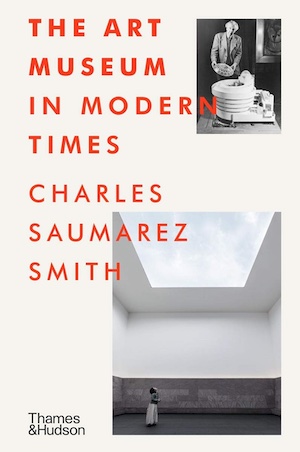By Svetlana Alpers
The moment is ripe for a book on the art museum in these times. In America awareness of museums has been heightened by the closure and then limited re-opening of buildings, but even more by questions raised about the cultural politics of choosing trustees, patrons, curators, and collections. These days American museums are under pressure.
Charles Saumarez Smith does not turn to these issues until near the end of the book.
He is generally upbeat about museums. Effectively, given our sense of the crises facing American museums, the book offers a breath of fresh air and hope. It is organized as a series of case studies of individual museums across the world. From New York to Tasmania to Susch, Switzerland, to Dubai, we are told details of who wanted a museum built, how that was done, and what it is like to get to a museum and then walk about inside.
Contrary to the current mood in America, this survey suggests that museums are alive and well with new ones being built (often with private money) all the time. It is amazing how many new and interesting museums there are and how many Saumarez Smith has visited often in the service of his career. Recently retired, he was previously, in an astonishing succession, director of the London National Portrait Gallery, director of the National Gallery, and chief executive of the Royal Academy.
Since Saumarez Smith started off with a Ph.D. in architectural history (written at the Warburg Institute on Castle Howard), buildings are central to his view of museums. Fair enough, given that (though surprisingly the author does not say so) designing a museum has become the way architects make a name for themselves in our time. If in mid-20th-century America it was corporate buildings like the Seagram, Lever House, or Pepsi lined up along Park Avenue, now designing a museum, often museums plural, has been the road to success for architects as different as Louis Kahn, I.M. Pei, Frank Gehry, and Renzo Piano.
The spread of the book is horizontal rather than vertical—by which I mean it is not a historical survey taking us back in time as much as it is global, reaching out geographically across space. There is much to be gained from the decision to make the time frame the last 80 years, but there are losses. Certain questions about the nature of the museum are literally left behind. The Louvre as visited here is not the palace building whose royal collection was transformed by the Revolution into a place for the people to look at art, but Pei’s glass pyramid and the mall beneath where crowds engage in shopping. What is missing is mention of the day set aside, at its beginning, for artists, and only artists, to enter in to look and to study, perchance to draw. Today, artists jostle to get museums to display their works; they no longer understand, nor are they encouraged to understand, the museum as a place for them to go, look, and learn.
But are museums that for anyone these days?
Saumarez Smith makes much of the turn away from historical installations. I myself think fondly back to the London National Gallery when turning to the left at the top of the great stairs and on opening the heavy wooden doors one entered into the history of Italian painting according to Vasari. You did not learn the sequence of makers by labels or by devices plugged into the ears, but by the slow experience of orderly visual attention as you walked. Visual attention could not be disrupted by the use of a camera.
The author suggests what has replaced sequence as instruction is the freedom for each visitor to make up his or her own experience. But I wonder. Contemplation (that is a word he uses) as encouraged by the design of some museums, seems to be taking over from visual attention. It is of course a very different thing. It is less trying to understand what is there before your eyes than being free to lose yourself in your own thoughts.
Saumarez Smith is full and generous in his necessarily brief account of each of many chosen museums. He is also clear and right-on about what is distinctive about each: writing correctly of the Gehry Guggenheim Bilbao that “what is more exciting is the view of the building from outside, as a feature in the surrounding city”; acknowledging that surveys show that visitors to the Tate Modern do not come to look at art but to encounter other people; and celebrating the defining aspect of the Beyeler Foundation as the sheer quality of the collection. A site, a milling crowd, or the selection of art each find praise.
In general what the book brought home to me is that I visit museums not for the museum, but for the objects I go to see or that I am, when there, surprised to find. I want the building to enable that—as does the Louvre through its many reorganizations, or the National Gallery in London as I knew it once. But it is not the building that matters. So that indeed the museum for me, as I knew when I first saw it decades ago, is Carlo Scarpa’s brilliant renovation of the Castelvecchio Museum in Verona. As Saumarez Smith writes, “Scarpa encouraged the viewer to focus on the work of art itself in an intelligent and purely visual way, undistracted by labels or its surroundings.”
My knowledge and my experience are not as wide as his. But that for me is what a museum should be.
Svetlana Alpers, an artist, critic, and renowned art historian, is professor emerita of the history of art at the University of California, Berkeley and a visiting scholar in the Department of Art History at New York University.




